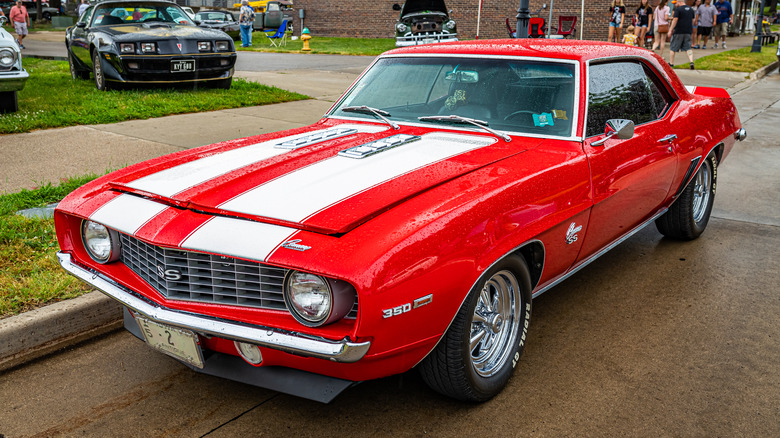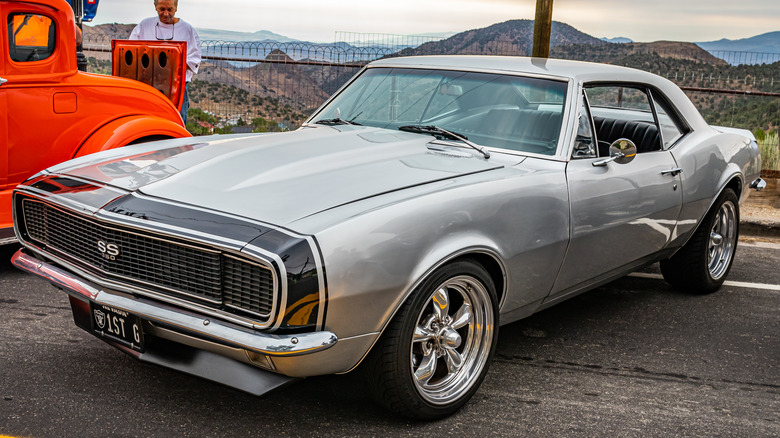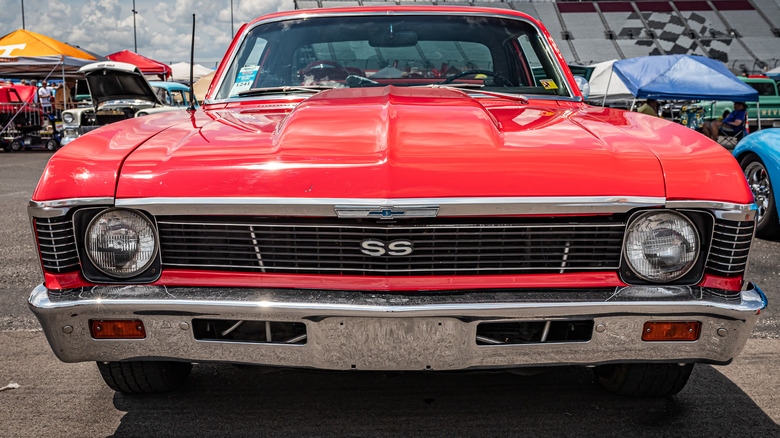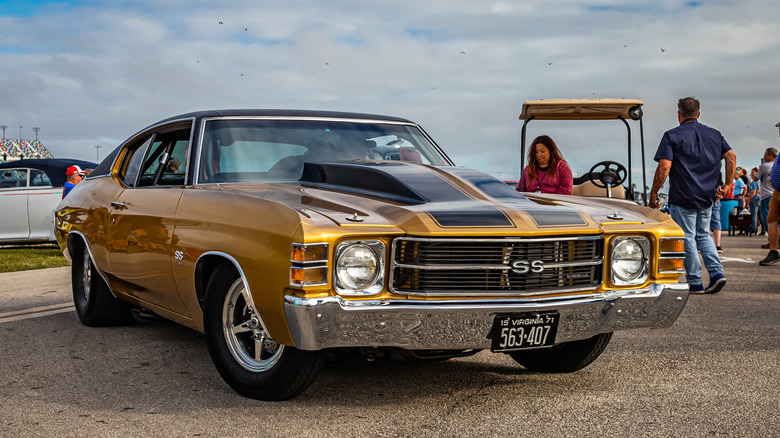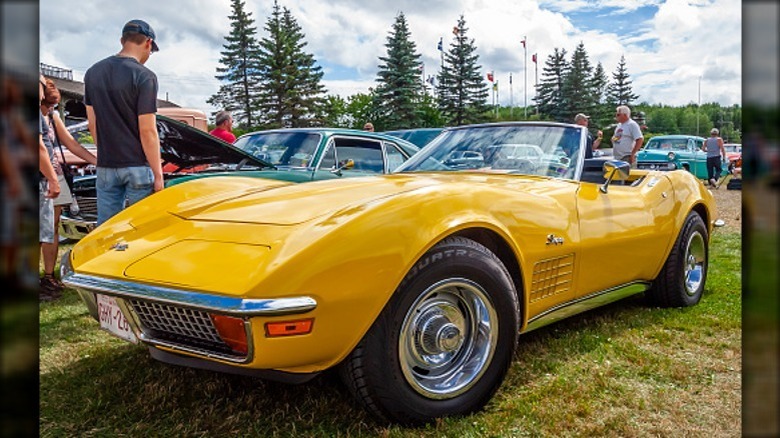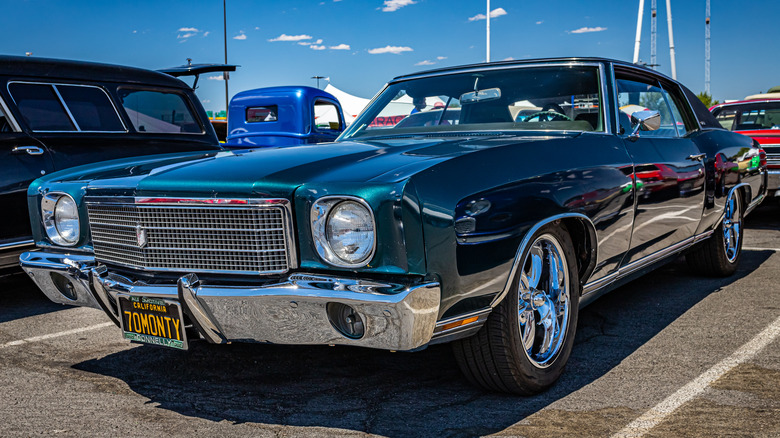5 Classic Chevys Powered By The Legendary 350 Engine
In the early years of the 20th Century, General Motors co-founder William Durant launched a bid to buy Ford that failed, leading to his ouster from the company. Durant then teamed with Swiss race driver Louis Chevrolet — who had previously driven for GM's Buick team – to form a new enterprise they called the Chevrolet Motor Company. Chevrolet expanded quickly, and Durant began to acquire stock in GM. By 1918, Durant had re-taken control of GM, and Chevrolet was moved under the General Motors umbrella.
As automotive design evolved in the decades that followed, Chevy turned its attention to building sportier and more powerful cars, and introduced the Corvette in 1953. That model sold for less than $3,500 (about $40,000 in 2024 money) and goes for as much as $700,000 today. Two years later, Chevy introduced its first V8 engine since 1918, a 265 cubic inch small block that produced between 180 and 240 horsepower (via Chevy Geek). Chevrolet small-block V8s grew steadily over the next decade, and by 1967 had settled in at 350 cubic inches (5.7 liters). The 350 would stay in Chevy's lineup in 17 different variations until 2002, ranging in output from 145 to 350 horsepower and 255 to 380 pound-feet of torque. During its long run, the Chevy 350 powered a wide range of vehicles, from econoboxes to muscle cars and pickup trucks. Here are a handful of classic Chevrolet models that had the long-lived and beloved 350 cubic inch small-block V8 under their hoods.
Camaro
The first Chevy to get the 350 cubic inch V8 was the 1967 Camaro SS 350. Opting for the L-48 option package gave buyers some interior upgrades, special badging, and the larger engine (the other options were a 230 cubic inch straight six and 327 and 396 inch V8). SS 350 models had a roll-cage to go along with the motor that produced 295 horsepower (via Automobile Catalog) with the stock four-barrel carburetor.
In its review of the 1967 Camaro SS, Car and Driver noted, "The youth market — or what's left of it after The Draft and tight money — is what the Camaro is aimed at, with older folks wanting in on the fun because that's where they think the action is." A '68 Camaro 350 SS owner commented on the review's recent reprint, noting that they paid $3,350 (just under $30,000 today) for a car that held local track records and won a state championship by turning a quarter mile in 13.56 seconds. The 350 stayed as an option on the Camaro until 1981, then returned to its papa from 1987 through 1997.
The last sixth-generation Camaro rolled off the line in January, but Chevy is holding on to the nameplate for potential future use.
Chevrolet II/Nova
In 1968, the 350 cubic inch small block was also offered in the Chevy II Nova, which was in its transition year from being called the Chevy II to its official rebadging as simply the Nova. Buyers of late-'60s Nova SS models could choose from 327 or 350 cubic inch small-block V8s or opt for big-block 396 or 402 cubic inch powerplants. For 1970, the 350 in the Nova SS got a boost to 300 horsepower (via Motor Trend), but by 1973, claimed power for the 350 had plunged to 175 horses. This drop was partially due to an industry-wide shift from reporting horsepower as gross output to citing net figures, a change that came in 1972.
That year, the SS trim was primarily an appearance package that came with a heavy-duty suspension and could be ordered with any engine, and by 1975, the most potent 350 V8 only made 155 horsepower. That weakened version of the engine stayed in place until the Nova went on hiatus after a truncated 1979 model year, and when the badge returned in 1985, the Nummi-designed new Nova had a 1.6 liter four-cylinder engine that produced just 74 horsepower.
Chevelle
Two years after it first appeared in the Camaro and the year after it was added to the Nova, the small-block 350 was also offered as an option on the 1969 Chevelle. The 350 was hardly the biggest engine available for second-generation Chevelle buyers; the option sheet also included 396, 427, and 454 cubic inch V8s.
The peak year for the Chevelle 350 was 1970, when the Malibu trim version's engine produced 300 horsepower and 380 pound-feet of torque, according to Automobile Catalog. The third generation model was introduced just as the oil crisis was dawning in 1973, and by the time the Chevelle was dropped after the 1977 model year, the 350 was left as the only V8 option for buyers. By that point, the 350 had been hobbled by emissions restrictions and net rating standards and only produced 170 horsepower (via Top Speed). Although the Malibu name had begun as a trim level of the Chevelle, it lived on as a standalone model, getting the 350 in 1978 and 1979.
Corvette
Chevy has produced the Corvette through eight generations beginning in 1953, and the 1969 model that kicked off the third generation's second model year was the first to get the 350 cubic inch V8. The C3's 350 replaced the previous generation's 327 cubic inch small block, but the ZL1 option added a 430 horsepower, 427 aluminum block V8 for 1969 only. The 350 remained as an engine choice in the C3 through the end of its run in 1982.
While '60s and '70s muscle machines like the Chevelle and Camaro only saw the earlier versions of the 350, C4 Corvette ZR-1s made between 1990 and 1995 got the updated LT5 350 small block V8. The 1990 model is regarded as the best of the C4 'Vettes, with the new 350 developed by Lotus and built by Mercury Marine cranking out 380 horsepower.
The updated 350 was a triumph for Corvette lead engineer Dave McLellan, who told Car and Driver, "We've achieved a spectacular level of performance and are still able to meet or exceed all government standards for fuel economy, safety, noise, emissions, and so on." The magazine tested the 1990 ZR-1 as able to go from zero to 60 mph in 4.5 seconds and to 150 mph in less than half a minute.
Monte Carlo
When Chevrolet introduced the Monte Carlo for the 1970 model year, it borrowed the platform from the Pontiac Grand Prix and the firewall, rear deck, and front and rear glass from the Chevelle. The Chevelle and Monte Carlo also shared a 116-inch wheelbase and recessed round headlights. The 350 was the standard engine option on the 1970 Monte Carlo, which had a base price of $3,123 (just under $25,000 in 2024 money). Buyers who added the full suite of options, including air conditioning, power steering, windows, and seats, paid more than $5,000, which equates to about $40,000 today.
Motor Trend declared the 1970 Monte Carlo "an unqualified success in every aspect, having a lot of luxury, a lot of performance, and a lot of value." Small revisions to the grille and lights were made in each of the next two years, but a major redesign came in 1973, along with a Motor Trend Car of the Year award win. The next year, sales jumped past the 300,000 unit mark, and in 1977, that number climbed past 400,000. By that point, American car buyers were moving into smaller, more fuel-efficient models. GM responded by shrinking the largest gas-powered V8 option to 305 cubic inches, although Chevy borrowed Oldsmobile's leak-prone 350 cubic inch diesel-powered V8 for use in the Monte Carlo.
